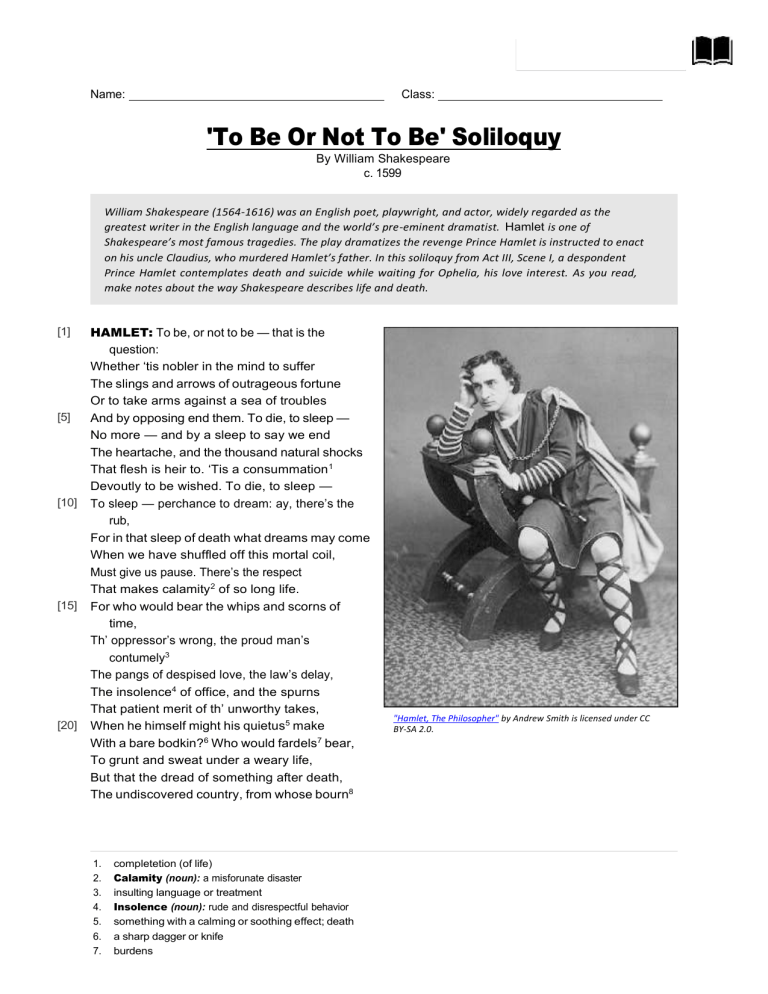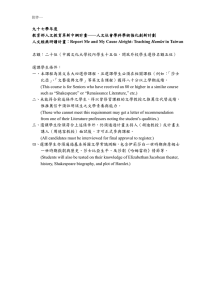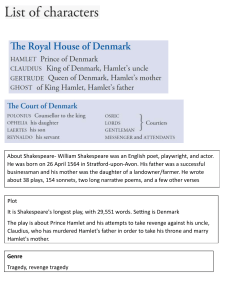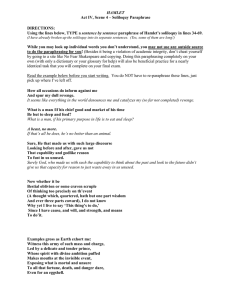
Name: Class: 'To Be Or Not To Be' Soliloquy By William Shakespeare c. 1599 William Shakespeare (1564-1616) was an English poet, playwright, and actor, widely regarded as the greatest writer in the English language and the world’s pre-eminent dramatist. Hamlet is one of Shakespeare’s most famous tragedies. The play dramatizes the revenge Prince Hamlet is instructed to enact on his uncle Claudius, who murdered Hamlet’s father. In this soliloquy from Act III, Scene I, a despondent Prince Hamlet contemplates death and suicide while waiting for Ophelia, his love interest. As you read, make notes about the way Shakespeare describes life and death. [1] [5] [10] [15] [20] HAMLET: To be, or not to be — that is the question: Whether ‘tis nobler in the mind to suffer The slings and arrows of outrageous fortune Or to take arms against a sea of troubles And by opposing end them. To die, to sleep — No more — and by a sleep to say we end The heartache, and the thousand natural shocks That flesh is heir to. ‘Tis a consummation 1 Devoutly to be wished. To die, to sleep — To sleep — perchance to dream: ay, there’s the rub, For in that sleep of death what dreams may come When we have shuffled off this mortal coil, Must give us pause. There’s the respect That makes calamity2 of so long life. For who would bear the whips and scorns of time, Th’ oppressor’s wrong, the proud man’s contumely3 The pangs of despised love, the law’s delay, The insolence4 of office, and the spurns That patient merit of th’ unworthy takes, When he himself might his quietus5 make With a bare bodkin?6 Who would fardels7 bear, To grunt and sweat under a weary life, But that the dread of something after death, The undiscovered country, from whose bourn8 1. 2. 3. 4. 5. 6. 7. completetion (of life) Calamity (noun): a misforunate disaster insulting language or treatment Insolence (noun): rude and disrespectful behavior something with a calming or soothing effect; death a sharp dagger or knife burdens "Hamlet, The Philosopher" by Andrew Smith is licensed under CC BY-SA 2.0. [25] [30] [35] No traveller returns, puzzles the will, And makes us rather bear those ills we have Than fly to others that we know not of? Thus conscience does make cowards of us all, And thus the native hue of resolution Is sicklied o’er with the pale cast of thought, And enterprise of great pitch and moment With this regard their currents turn awry And lose the name of action. — Soft you now, The fair Ophelia!9 — Nymph,10 in thy orisons11 Be all my sins remembered. “‘To Be Or Not To Be’ Soliloquy” by William Shakespeare (c.1599) is in the public domain. 8. 9. 10. 11. boundary Ophelia is the love interest of Hamlet in the play. Nymphs are beautiful mythological spirits of nature. prayers Text-Dependent Questions Directions: For the following questions, choose the best answer or respond in complete sentences. 1. PART A: Which of the following best states a theme of the soliloquy? A. B. C. D. 2. PART B: Which of the following quotes best supports the answer to Part A? A. B. C. D. 3. “To die, to sleep — / No more — and by a sleep to say we end / The heartache, and the thousand natural shocks / That flesh is heir to. ‘Tis a consummation / Devoutly to be wished.” (Lines 5-9) “For who would bear the whips and scorns of time, / Th’ oppressor’s wrong, the proud man’s contumely / The pangs of despised love, the law’s delay, / The insolence of office, and the spurns / That patient merit of th’ unworthy takes, / When he himself might his quietus make” (Lines 15-20) “The undiscovered country, from whose bourn / No traveller returns, puzzles the will, / And makes us rather bear those ills we have / Than fly to others that we know not of?” (Lines 24-27) “And thus the native hue of resolution / Is sicklied o’er with the pale cast of thought, / And enterprise of great pitch and moment / With this regard their currents turn awry / And lose the name of action.” (Lines 29-33) PART A: How does Shakespeare use figurative language to talk about death? A. B. C. D. 4. Suicide is not only tragic but morally wrong, and should be discouraged. When life is full of pain and struggle, it is worthwhile to end one’s life rather than suffer. It is better to take one’s own life rather than take another’s in the name of revenge. Life is full of struggle, but the great unknown of death is far more fearsome. Shakespeare compares life to a nightmare and death to peaceful sleep. Shakespeare compares life to crossing into new countries and death to being in a fixed state. Shakespeare compares life and death to battles in which one has the choice of fighting. Shakespeare compares death to sleep and dreams to the afterlife. PART B: Which TWO quotes from the text support the answer to Part A? A. B. C. D. E. F. “‘tis nobler in the mind to suffer / The slings and arrows of outrageous fortune” (Lines 2-3) “take arms against a sea of troubles / And by opposing end them.” (Lines 4-5) “and by a sleep to say we end / The heartache, and the thousand natural shocks / That flesh is heir to.” (Lines 6-8) “For in that sleep of death what dreams may come / When we have shuffled off this mortal coil, / Must give us pause.” (Lines 11-13) “That patient merit of th’ unworthy takes, / When he himself might his quietus make / With a bare bodkin?” (Lines 19-21) “But that the dread of something after death, / The undiscovered country, from whose bourn / No traveller returns” (Lines 23-25) 5. How does Hamlet’s conclusion on the question of “To be or not to be” develop the reader’s understanding of his character? Discussion Questions Directions: Brainstorm your answers to the following questions in the space provided. Be prepared to share your original ideas in a class discussion. 1. How does Hamlet describe life? How does he describe death? Do you agree with Hamlet’s view on life and death? 2. Is the question “to be or not to be” the most important question we can ask ourselves? Cite evidence from the text, your personal experience, and other literature, art, or history in your answer. 3. Why do you think this particular excerpt from Hamlet is so famous? Do you think it is as relevant today as when it was first written?






